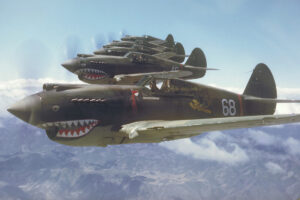Those who have served know that war is not romantic. It is destruction and death. Yet, certain aspects of conflict have been romanticized. In the lore of World War II fighting men and machines the P-40 ranks at or near the top of this list. The American volunteer group in China, organized in 1941 under General Claire Chennault, flew 180 P-40’s. They were dubbed the Flying Tigers. Between December of 1941 and July 1942 they destroyed a total of 299 Japanese aircraft while only loosing 12 P-40s in combat. Seven months after Pearl Harbor, they were absorbed into the US Army Air Force as the 23rd Fighter Group and served in China and South East Asia for the duration of the war. What the Flying Tigers accomplished in such a short period of time ensured their lasting fame in the annuals of wartime aviation. The P-40 was not an aircraft without problems. It was always adequate but was also always just a step behind its competitors and enemies, particularly in the area of altitude performance. Development was continuous in an effort to produce its successor. Yet, each proved to possess two small a margin of improvement to Merritt interruption of assembly lines. No less than four different engines and three cooling systems were tried at one time or another.
The P-40 never quite achieved the performance levels set for it. Yet, it had a highly successful history. It proudly served the air forces of eight allied nations and compiled impressive combat statistics in all theaters of the war. While the engineers were never quite satisfied with the craft, the men who flew them swore by the fighters reliability and performance. Perhaps these men were downgrading their own skills. Although the P-40 was often outmatched on the drawing board, it was a marvelous machine in aerial combat. One must conclude that the pilots skill accounted for this contradiction.
 Nothing represents the legendary Flying Tigers like the fearsome sharks teeth painted on the aircraft by the pilots mechanics and crew of the men who served with Gen. Claire Chennault in the American volunteer group. These roaring machines truly instilled fear in the hearts of the opposing pilots.
Nothing represents the legendary Flying Tigers like the fearsome sharks teeth painted on the aircraft by the pilots mechanics and crew of the men who served with Gen. Claire Chennault in the American volunteer group. These roaring machines truly instilled fear in the hearts of the opposing pilots.
The AVG had another unit emblem that became just as well known as the Sharks Teeth. The Flying Tiger Itself. The Iconic Winged Tiger was hand drawn by Walt Disney himself. His staff artists created decals for the sides of the aircraft as well as for the unit members wooden lockers or “Trunks,” Walt Disney even had some hand painted leather patches created for the pilots jackets.
I had the pleasure in my early career to have met a number of the fearless men whom volunteered to protect the Chinese against invasion and to maintain a foothold before the U.S officially entered the war. This was one of my earliest pieces and it proved to be one of the most popular. In fact it was so popular that I created many different incarnations of the various P-40 models from full size panels to custom sections and scaled down panels for framed Shadow Boxes that include lithographs of the P-40 profile painting.
I had the honor of having two such panels signed by no less than 5 of the Famed AVG Flying Tigers at a 1995 event at the Military Art Gallery, Harper Woods Michigan.
Below you can see the signatures on the P-40E Hull in honor of all the tigers.
Major General Charles R. Bond, jr.
John Richard” Dick” Rossi
Lt. Colonel Charles H. Older
Brigadier General David Lee “Tex” Hill

